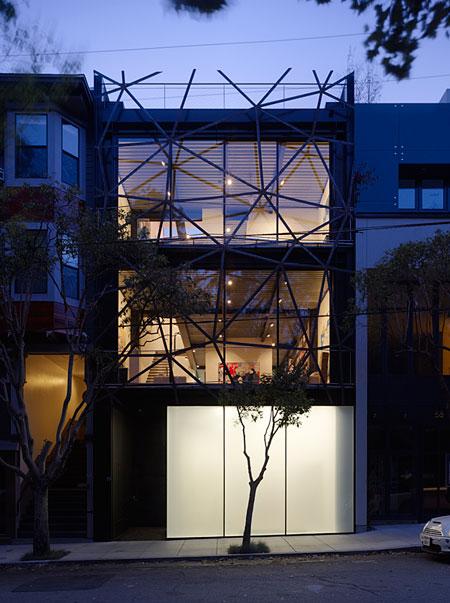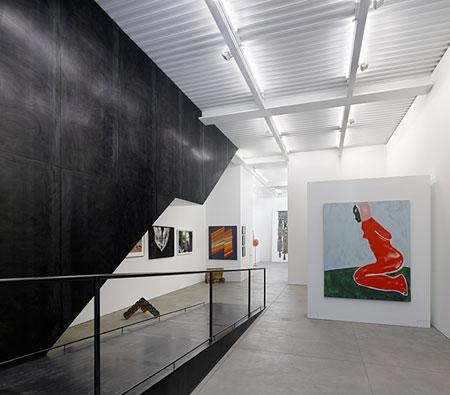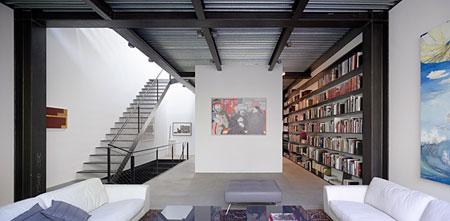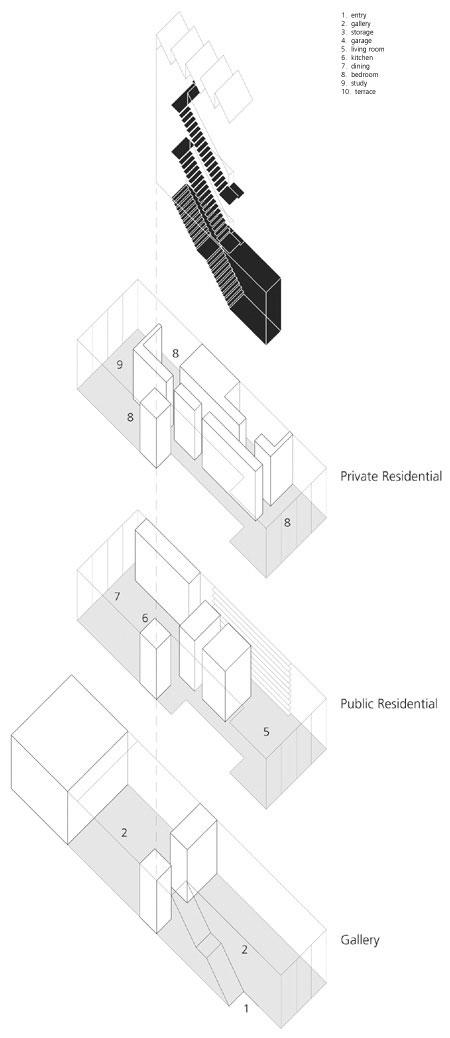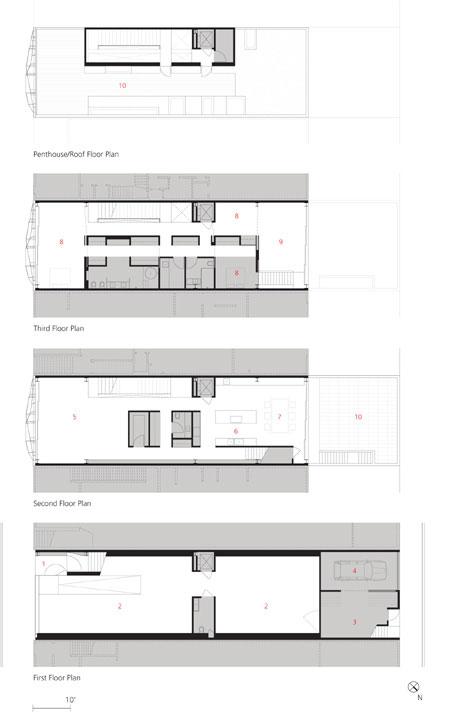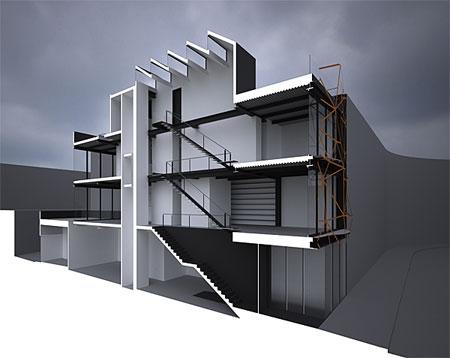Gallery House
21. 5月 2010
San Francisco's Ogrydziak/Prillinger Architects answered some questions about their Gallery House in the same city. The unique program, melding a residence and art gallery, presents itself publicly in a steel screen based on old algorithms and new technologies.
Exterior - street facade dusk
Photos: Tim Griffin
What were the circumstances of receiving the commission for this project?
The clients worked with several architects and met with many others before we were recommended by a friend. Perhaps they were already exhausted from the process, but I think they were happy to find architects who understood that in their case, it was more important for the architecture to operate primary in the service of the functional exhibition of their extensive art collection than as an expressive gesture in its own right.
Interior - ground floor gallery
Can you describe your design process for the building?
Hybrid program
The clients proposed an unusual domestic typology: a 'gallery house.' The project combines a semi-public art gallery and a residence for two prominent collectors who have redefined what it means to live with and look after art. The clients, a virologist and a mathematician, exclusively collect work by female contemporary artists and feel compelled to share and promote their collection, not only with friends but also with the larger art world. They requested a home within which both their extensive collection and visitors could circulate from a semi-public gallery through to the domestic space, each zone offering a different environment for experiencing the work. The street-level gallery hosts exhibitions curated from their private collection as well as the collections of friends. A site for artist and curator talks, the gallery increases public engagement in the arts within the art world as well as at the scale of their own neighborhood. Extending and redefining the exhibition space as it continues up the stairs to the next two floors and the penthouse sculpture garden, the domestic zone includes even the most private spaces in the exhibition circuit by virtue of its open plan.
Figural voids
The site is an infill lot bordering South Park, one of the few figural public spaces in San Francisco. This distinctive urban condition informed the search for an abstract architectural language that explores the interlocking clarity of figure-ground relationships and the liminality of their edge conditions. The design process began by seeing the base condition of the lot as solid poche, already full. The solid mass of the buildable envelope was then incised and subdivided into interlocking elements. The space of the lot was comprehensively partitioned and the interlocking figures identified as solid or void, and assigned various programs. In this manner, the original fullness of the space was articulated and accounted-for, resulting in a perceptible heaviness in the built project.
Soft edges
The solids and voids slide past each other, indifferent to the abstract 4 x 5 x 4 Cartesian framework that informs the structural system. Within the house, the matrix reinforces the divisions of space implicit in the allocation of solids and voids. But at the façade that meets South Park, the orthogonal framework dissolves and reassembles to emulate the organic morphology of the tree-filled park. The tessellations flex to create a volumetric inhabitable space for balconies on the upper two floors. This swollen threshold resulted from an exhaustive taxonomy of parametric interpretations of the Planning Code constraints for allowable projections that trigger the typical San Francisco bay window. The soft geometries of the facade screen reappear in the 'mathematical-organic' pavers and succulents at the rooftop sculpture garden.
Interior - living room
How does the completed building compare to the project as designed? Were there any dramatic changes between the two and/or lessons learned during construction?
The major change or development was in the pattern of façade screen. When the building was initially designed, the clients wanted the façade screen to create a visual buffer between the house and the park, but as construction got underway and they were able to occupy the spaces that directly overlook the park, they realized that they would prefer it to be quite transparent, operating more as a suggestion of a boundary than as a literal privacy screen. The volumetric form of the façade zone resulted from a formal taxonomy of potential misreadings of the San Francisco Planning Code with regard to the definition of allowable bay windows projections, and was approved as part of the original design permit. However, the pattern of the façade screen resulted from about a year and half of design research exploring various strategies for how to manifest the form of the permitted projection. Ultimately, we decided to create a ghostly lattice which would both imply the form but retain a high degree of porosity to the park. The specific strategy used for this is a Delaunay tessellation - a classic algorithm, first invented/discovered by the Russian mathematician Boris Delaunay in 1934. This algorithm efficiently triangulated a set of points P, and is commonly used for landscape and other organic meshes because of its efficiency describing organic forms. More explicitly, we created a field of buffered locators, which we projected onto our previously established blanket form, then tessellated using the Delaunay algorithm. The resulting triangular mesh was then fabricated in Cor-ten steel.
Diagram - exploded axonometric
How does the building relate to contemporary architectural trends, be it sustainability, technology, etc.?
Sustainability / daylighting
The envelope of the house responds to the temperate but varied climate and weather of San Francisco with a nuanced ability to shelter and protect from the cold fog, then open for a full connection to sun and breeze. Radiant floors warm the interior while large operable walls connect the large rooms to the park and trees on the southeast and the city as view to the northwest. In contrast to the horizontal expansion offered by the operable walls on both residential floors front and back, a green roof with drought-resistant plants is pierced with skylights to bring surprising and intense daylight to the deeper interior rooms. Over the 55' high vertical space of the stairs, a sawtooth roof washes the space and art with even north light. In the gallery, the south storefront diffusing glass is coupled with a northern skylight over the back display wall, providing daylight for the art throughout the cycles of the day and the year. The house and gallery track the climatic and sky cycles, from east to west and blue sky to fog, locating the occupants in a building that engages in the city with little reliance on bought fuels and off-site energy.
Floorplans
Are there any new/upcoming projects in your office that this building's design and construction has influenced?
Most of the work in the office currently implements some aspect of the research we have been developing over the last few years that involves computer programming to generate organic structures. The resultant work is ‘post-parametric' - inasmuch as the basic form generation often involves growth with collision-detection rather than parametric relationships. Synthetic environments are set up via C++ programs, in which space is filled up to a given density or time limit. The results from such processes are irreducible, insofar as they record the process of their own growth. Some current research projects simply present the growth paths; other projects begin by growing points, which are subsequently tessellated into 3d meshes and projected onto curving surfaces. In several recent projects OP uses the Delaunay tessellation - a classical (1936) algorithm which efficiently describes organic meshes. In the Gallery House this kind of design is manifest in the façade, the concrete roof pavers, and concrete plinths.
E-mail interview conducted by John Hill
Diagram - section
Gallery House
2009
San Francisco, CA
Architect
Ogrydziak/Prillinger Architects
San Francisco
Design Principals
Luke Ogrydziak
Zoë Prillinger
Project Team
Haemi Chang
Leo Henke
Yasmin Vobis
Gisela Schmoll
Structural Engineer
Santos & Urrutia
(Building)
DeSimone Consulting Engineers
(Facade)
Landscape Architect
Ogrydziak / Prillinger Architects
Lighting Designer
Ogrydziak / Prillinger Architects
Daylighting Consultants
Loisos + Ubbelohde
Contractor
Forsythe General Contractors
Site Area
2,420 square feet
Building Area
5,800 square feet
